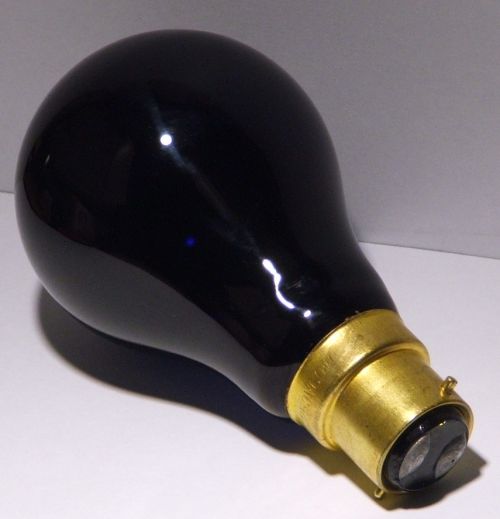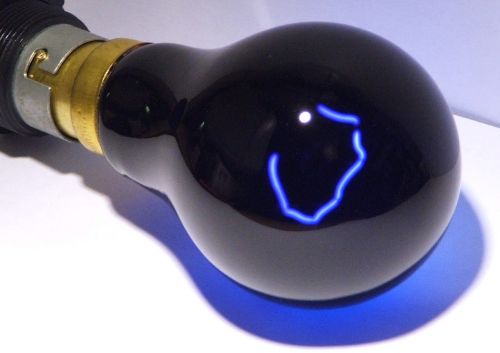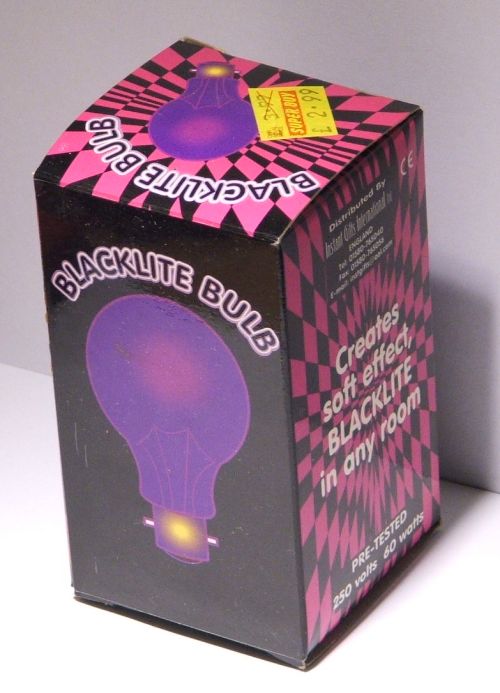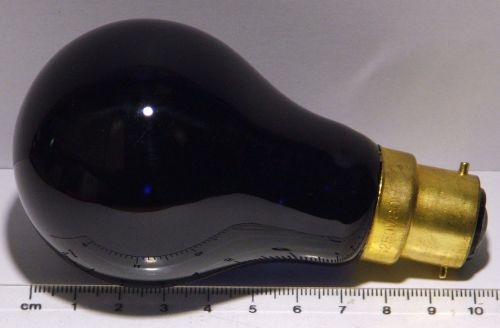
| Manufacturer: | Unknown. Distributor: Instant Gifts International |
| Model: | Blacklite Bulb |
| Application: | Visual Effects - Fluorescence |
| Wattage: | 60W (Measured: 61W) |
| Diameter (max): | 55mm |
| Length: | 100mm |
| Tube Length: | -- |
| Bulb/Tube material: | Wood's Glass |
| Colour Temperature: | Unknown |
| Peak output wavelength: | Broadband Emission - Attenuated between around 700nM and 400nM |
| Total light output: | Unknown |
| Rated lifetime: | Not Stated |
| Cap: | B22 |
| Operating voltage: | 250V AC |
| Operating current: | 247mA |
| Warmup/restrike time: | N/A |
| Cost (original): | £2.99 (2003 from Eastside Discount Warehouse, Banff) |
| Place of manufacture: | China |
| Date of manufacture: | Unknown. Assumed 2002-2003. |
| Lamp Status: | Working |
These things have been around for a long while. To be honest, I cannot really see and purpose for their continued existence. In every way they are out performed by linear/compact fluorescent "black lights".
Due to the relatively low running temperatures of the filaments in common incandescent lamps, very, very little UV is actually produced. To try to squeeze a little more UV from the filament, the companies which manufacture this type of lamp tend to overdrive the filament - making it run far hotter than normal. This does provide more UV emission - but also has a huge impact on lamp life. Generally these lamps have rated lifetimes of between 100 and 500 hours (rather than around 1000 for a standard incandescent lamp of the same rating). Even then though, the lamp will be producing relatively little UV. Some examples similar to this I have seen simply use a normal glass bulb and apply a deep violet coloured coating externally. My example hasn't cheated to quite that extent, and does actually have a Wood's Glass bulb. Wood's Glass is glass with a higher than usual concentration of nickel and iron oxide present, which causes it to be almost totally opaque to most visible light (apart from some deep red and violet), and any shortwave UV. It does however allow long wave ultraviolet (UV-A) to pass through relatively unimpeded.
This lamp appears to be in the overdriven category - producing far more heat than you would expect from a 60W source (it actually managed to burn a patch in the paper in the few seconds it was on for me to get that photograph), but despite that only crates a pitiful amount of UV. Barely even managing to make the paper glow, and having really very little effect on fluorescent objects (being illuminated just as much by the visible emission than by fluorescence). The colour of the glass also appears to be a little uneven - one side allowing through far more light than the other. Varying from a fairly pale blue colour on one side to a much deeper violet on the other. A single 5mm UV LED is more effective for providing a source for the purpose of making things fluoresce - and it'll run on 20mA at a few volts...rather than 250mA at 250V...We won't even bother comparing it to my main fluorescent black light (F15T8BLB fixture), as it's like comparing a unicycle to a Ferrari F-50.
For the above reasons, I really do not see that this lamp serves any practical application - but it is an example of lighting technology, and as such deserves a place in the collection.

Instant Gifts International Blacklite Bulb - General overview of lamp

Instant Gifts International Blacklite Bulb - Detail of lamp cap

Instant Gifts International Blacklite Bulb - Lamp shown while alight

Instant Gifts International Blacklite Bulb - Lamp packaging

Instant Gifts International Blacklite Bulb - Showing size of lamp

Added to the Virtual Display Shelf at: 12:16 on Monday 26th September 2005.
This page last updated:
17th June 2023: Changes to page formatting to improve readability on mobile devices and some background code changes to improve search engine behaviour.